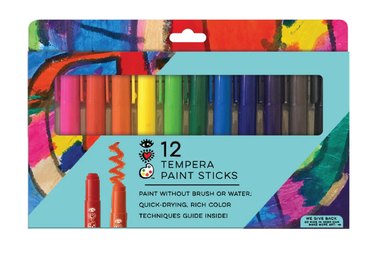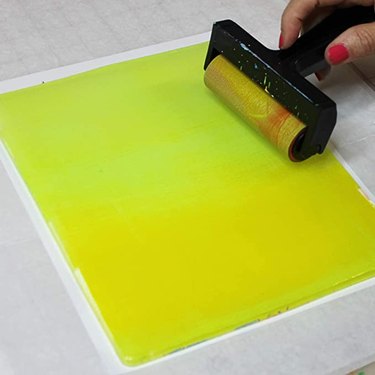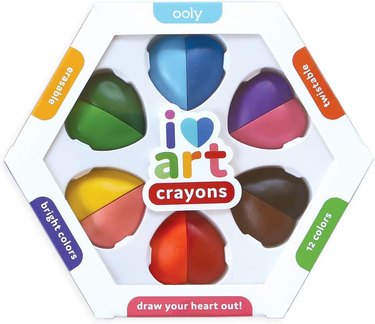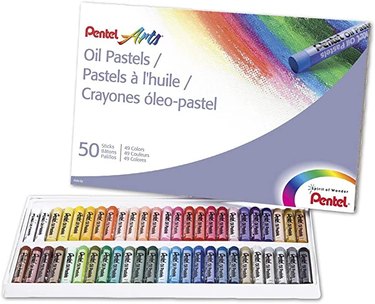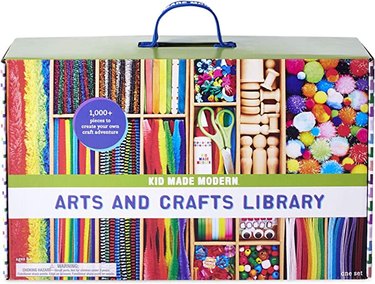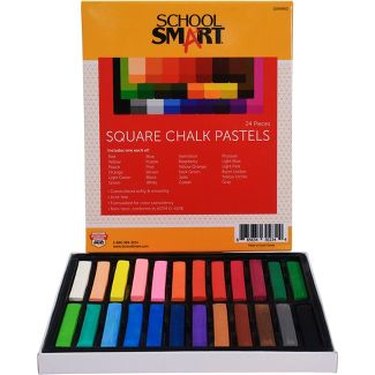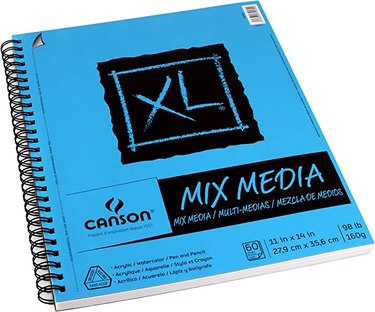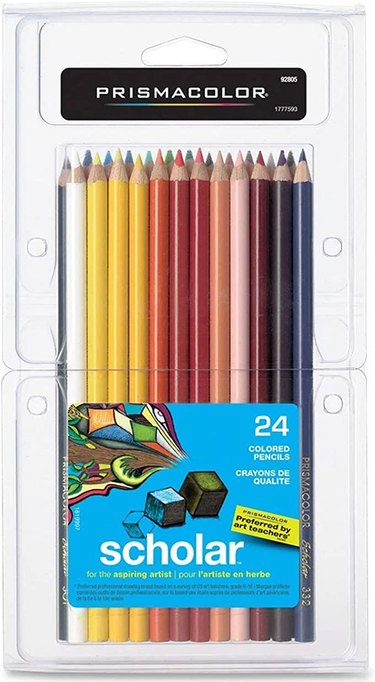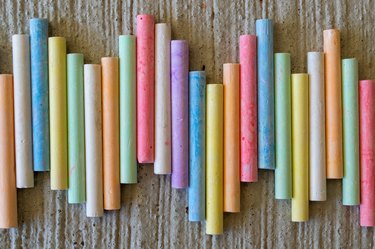
Who can forget the allure of childhood finger-painting, chalk art and creating your very first watercolor or acrylic paint self-portrait (even if it looked more like a square with a circle on it than an actual portrait)? There's nothing like arts and crafts to boost a kid's creativity, imagination, self-expression and self-esteem, all while helping them to practice fine motor skills and problem solving. Even if your kid's not a future Picasso, a good art project is a fun way to get them thinking outside the box.
And you don't have to wait for back to school season or art class to hone these developmental and creative benefits. We turned to art educators and art therapists from around the globe to get their take on the best art supplies and art tools to have on hand when creativity strikes, plus any fun project ideas they love.
Video of the Day
Video of the Day
All these supplies can be easily found at a craft store. And, when in doubt, take a tip from art therapist Tami Earnheart: Go for craft supplies that are novel or packaged in an intriguing way. "When craft supplies are different from their usual standard school supplies, it can really spark involvement and engage kids in the art process," she says.
1. No-Mess Paint Sticks
iHeartArt 12 Tempera Paint Sticks
Picked by: Meg Bourne, founder and CEO of Art Feeds, a nonprofit based in Fayetteville, Arkansas that develops art lesson plans for educators and parents to promote social-emotional learning in children.
Why: "These paint sticks create the painting experience and texture without the mess! There's no risk of knocking over water basins filled with paintbrushes, plus cleanup is easy, and there's no wasted and dried paint in a paint pallet. One fun way to use them? Art Feed's Calming Half Circles project encourages kids to align their painting with their breathing (draw a line when you breathe in and start to color when you breathe out) to move through feelings."
Tip
Encourage kids to take pride in and display their work—it'll inspire them to keep creating! One easy and affordable way to display art? Take a yard stick and glue clothespins to it. Attach it to the wall and hang the artwork from the pins. Think of it like your own mini museum!
2. Printing Plates
Gelli Arts Printing Plate
Gelli Arts Mini Printing Tools, Set of 3
Picked by: Kate Driscoll, a primary school art teacher in Perth, Australia; @art__teacher__life on Instagram
Why: "Gelli plates are soft gelatin plates used for mono-printing. Paint is placed onto the plate and rolled out with a brayer roller. Kids can use stencils, texture tools like scrapers or even just their hands to make imprints on the plate and then make a print on the paper. Layers of prints on top of each other make for beautiful and interesting designs. In my class, I pair students and have them mix colors, experiment with different stencils and layer prints on top of each other."
3. Erasable or Washable Coloring Tools
OOLY Erasable Crayons
Picked by: Tami Earnhart, a registered art therapist and licensed family and marriage therapist in San Diego, California
Why: "I work with kids struggling with anxiety, and they can worry a lot about mistakes. So much so that they may avoid using colors because they might choose the 'wrong' color or color something 'wrong.' Having coloring tools that erase, like erasable crayons, pencils or markers, can help ease them into using more color and eventually transition to other materials that aren't erasable. It's sort of a step-up approach."
Tip
The great thing about crafts is that you can start simple—think construction paper, glue sticks and craft paint simple—and then get more specialized as you go: mosaics, tie-dye, quilting, wood crafts and even die-cutting. One fun way to see what your kid might like in the arts realm? Take them to a museum (virtual or in person) and see what they naturally gravitate toward. Is it a dinosaur exhibit or maybe a quilting display? Great! That can inform their next craft project.
4. Molding Clay
Crayola Model Magic Air-Dry Clay, 5 lb. Tub
Picked by: Katie Mallette, an elementary school art teacher in Boerne, Texas; @katieplus4 on Instagram
Why: "I'm a big fan of Crayola's Model Magic Clay. The white clay is so versatile for kids. They can color it with a marker and then mix the clay to create their own color. I love using it for an 'ice cream' craft project with students. Simply color the clay and put it in a bowl. Mix glue and a water-based paint together to make ice cream 'syrup' and squeeze it on top. Add real (or paper) sprinkles and voila! If you want it to look shiny, add a coat of Mod Podge on top when it's dry. It's an awesome kids' party craft that looks like you worked really hard. And it's a hit with both kids and parents!"
Tip
Did you know?
The medium of clay also has anxiety-relieving benefits. “Clay can be very soothing,” says art therapist Tami Earnhart. “In initial therapy sessions, I have kids roll out clay in a slow, gentle rhythm to help calm children who may feel nervous. The kinesthetic qualities of working with clay using both hands also work well with kids who have higher energy.”
5. Colorful Oil Pastels
Pentel Arts Oil Pastels, 50 Color Set
Picked by: Emily Clare, an art educator and painter in Sheffield, England and a blogger at Fine Art Tutorials
Why: "Oil pastels are a great choice for kids who are just starting to explore the world of art. They bridge the gap between painting and drawing, as you can hold them in your hand to draw and create expressive marks, but they provide wonderful, vibrant colors that blend into one another and look painterly on the paper. Student-grade and hobby-grade pastels, such as Pentel, are also good choices for kids because they're relatively inexpensive and harder in texture than the professional artist-quality ranges of pastels. This means that they will be much more forgiving for children who are learning how to apply the right amount of pressure with their materials."
6. All-in-One Crafting Kits
Kid Made Modern Arts & Crafts Library
Picked by: Kathleen Fletcher, CEO of the crafting website Kitty Baby Love and former art therapist in Virginia
Why: "As someone with a particular love of crafting, my recommendation is an all-in-one crafting kit, complete with 1,000 pieces and different materials to craft with. Not only can you get creative and DIY your own crafts but you can use an adhesive of your choice to glue materials on top of a printed coloring sheet or paper craft to add depth. For example, adding googly eyes, pompoms, craft sticks or other embellishments to a drawing of a caterpillar takes the picture to the next level—and the next dimension!"
Tip
Always decorate your supply box, says Fletcher. "I repurpose an old container to store most of the different supplies that come in a craft kit like the one above. The best part? Kids can decorate the container using some of the supplies that are going into the storage container!"
7. Kid-Friendly Sewing Kits
My First Sewing Kit
Picked by: Jane Kallinger, editor of SewingFromHome.com and crafting teacher in Pennsylvania
Why: "I've given this as a gift to a number of friends and relatives and can honestly say it's an excellent way for children to get started with crafting. It's perfect for ages 5 and up and any gender. The quality is excellent, and the instructional illustrations are beautiful and clear, which means you can almost leave the little ones on autopilot, although I would recommend sitting with them while they get started. Bonus: It comes in a travel case that's super useful for trips near and far."
8. Chalk Pastels
School Smart Assorted Chalk Pastels, Set of 24
Picked by: Betsy Komarchuk, art educator and artist in Denver, Colorado; @komarchuk_classroom on Instagram
Why: "A lot of teachers shy away from chalk pastels because they're soooo messy. But, with proper instruction, they can be really effective to teach blending and color mixing. I recently had students make toucan and chameleon drawings with chalk pastels since the color possibilities were endless. Word to the wise: Give students a piece of paper to work with that's large enough to be used as a sort of placemat while they work. It'll collect all the extra dust. Then, once they're done, they can take the paper to the sink or trash can and simply tap the dust off. Clean and simple—and fun!"
9. Mix-Media Drawing Pad
Canson Mix-Media Paper Sketchbook
Picked by: Kelsey Escue, a K-12 art educator and artist in Toledo, Ohio; @sqcreates on Instagram.
Why: "A mixed-media sketchbook is a great way for kids to discover which mediums they like so they can broaden their artistic horizons. Have kids practice with different supplies on the various pages, from pencils to markers to paint. And let kids draw or doodle whatever they like. If they really like cats, have them draw a cat in each of the mediums. Think of it like a science experiment where the constant is the subject matter and the variables are the different paper textures and tools."
Tip
Don't forget to focus on the play behind arts and crafts—it'll get kids creating more freely. For example, encourage make-believe and pretend play by equipping kids with tools and accessories that'll make them feel like a real artist. An artist's apron, like one from Michaels with pockets for supplies, or an easel is a great way to help your crafter channel their inner Leonardo da Vinci all while having fun.
10. Quality Coloring Pencils
Prismacolor Scholar Colored Pencils, Set of 24
Picked by: Chris Bernholdt, a high school visual arts teacher in Collegeville, Pennsylvania; @mrb.artteacher on Instagram
Why: "These pencils are like owning a Ferrari versus a Jeep! Sure, a Jeep is cheaper, but performancewise, there will never be a let-down in quality with a Ferrari. Too many 'student grade' coloring pencils are too hard and don't give students rich colors and a variety of values. If you have to push too hard on a colored pencil to get any decent color, you know the quality isn't there. And you don't have to break the bank—there are many quality yet affordable options. So why waste your money on subpar coloring pencils?"
